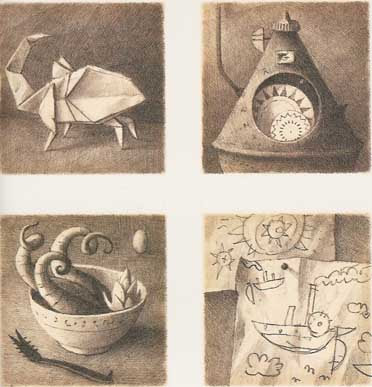Interpreting The Arrival
 Shaun Tan designed The Arrival to look like a weathered scrapbook. The paper-over-boards cover shows a fraying leather binding. The tones of the interior art are muted to sepias, their lines blurred, all to recall photographs from a century ago.
Shaun Tan designed The Arrival to look like a weathered scrapbook. The paper-over-boards cover shows a fraying leather binding. The tones of the interior art are muted to sepias, their lines blurred, all to recall photographs from a century ago.
As this sample from New York magazine shows, many of those images are reminiscent of photographs of Ellis Island in New York harbor. Indeed, Tan writes in his author's note of studying pictures of immigrants arriving there from Europe.
Interestingly, Tan himself is Australian, not American. Like his main character, he appears to be from Asia, not Europe. Apparently the Ellis Island experience not only stands for all US immigrant experiences, but carries similar resonance in some places overseas.
The book opens with a page of small drawings of household objects that any reader would recognize: an origami bird, a clock, a cooking container, a child's drawing of her family, and more. The pictures then follow a man as he leaves his family and boards a steamship, eventually arriving in a strange harbor.
The pictures then follow a man as he leaves his family and boards a steamship, eventually arriving in a strange harbor.
And strange the book becomes at that point. Everything appears in unfamiliar forms, from the immigration authorities' uniforms and examination instruments to this society's writing system and modes of transportation. Even the animals and vegetables are like nothing we've seen before (though they're shaped oddly much like each other).
All this comes at us in a series of sequential images, somewhere between that album of snapshots and the well defined panels of a traditional comic. There are no word balloons or captions. What labels and writing appear in the images are unintelligible to us.
That lack of words and explanations plunges us readers into the immigrant experience. We watch the man walk down the street, a street in a strange world. He doesn't speak the language, he holds no currency. As the protagonist struggles to express himself across the language barrier (as shown yesterday), we struggle to follow what happens to him.
The man finds an apartment, though the appliances take a lot of getting used to. He gets a job hanging posters, but he pastes them upside-down because he doesn't know the lettering. Eventually he ends up working on an assembly line; the factory's product, like so many other objects in the book, is impossible to identify.
Occasionally The Arrival breaks for some side narratives, two- or three-page stories of other immigrants. There's a woman fleeing oppression, a man caught up in a war, a shopkeeper with a young son. But we come back to the initial protagonist as the months pass. Finally he is able to send for the wife and young daughter we saw in the first pages.
Toward the end of the book, we see another page of objects from the family's life, the equivalents of the first. But now those objects reflect the flora, fauna, and culture of their new country. They have arrived.
The Arrival was shortlisted for the 2007 Cybils Awards in the category of graphic novels for teens--more about that tomorrow.


1 comment:
Funny little Paul Simon reference in there. Works.
Post a Comment